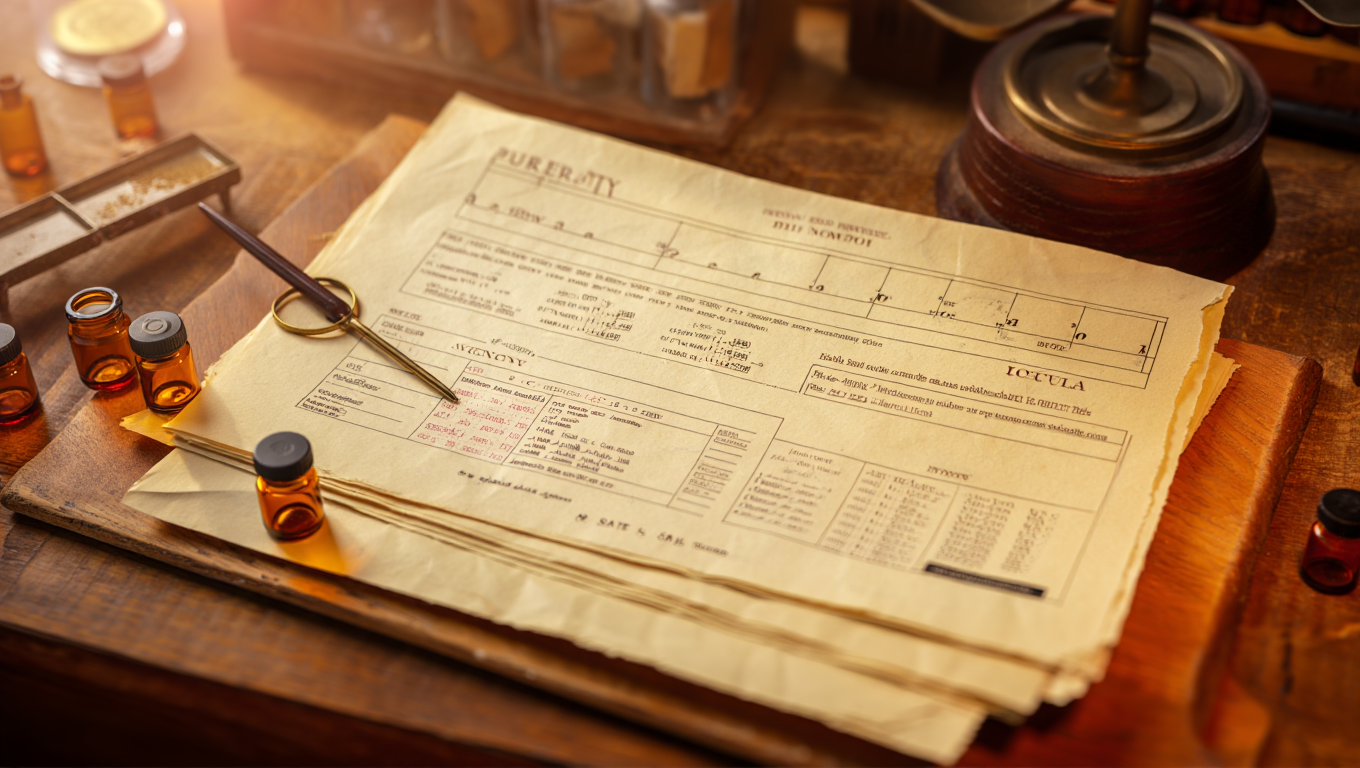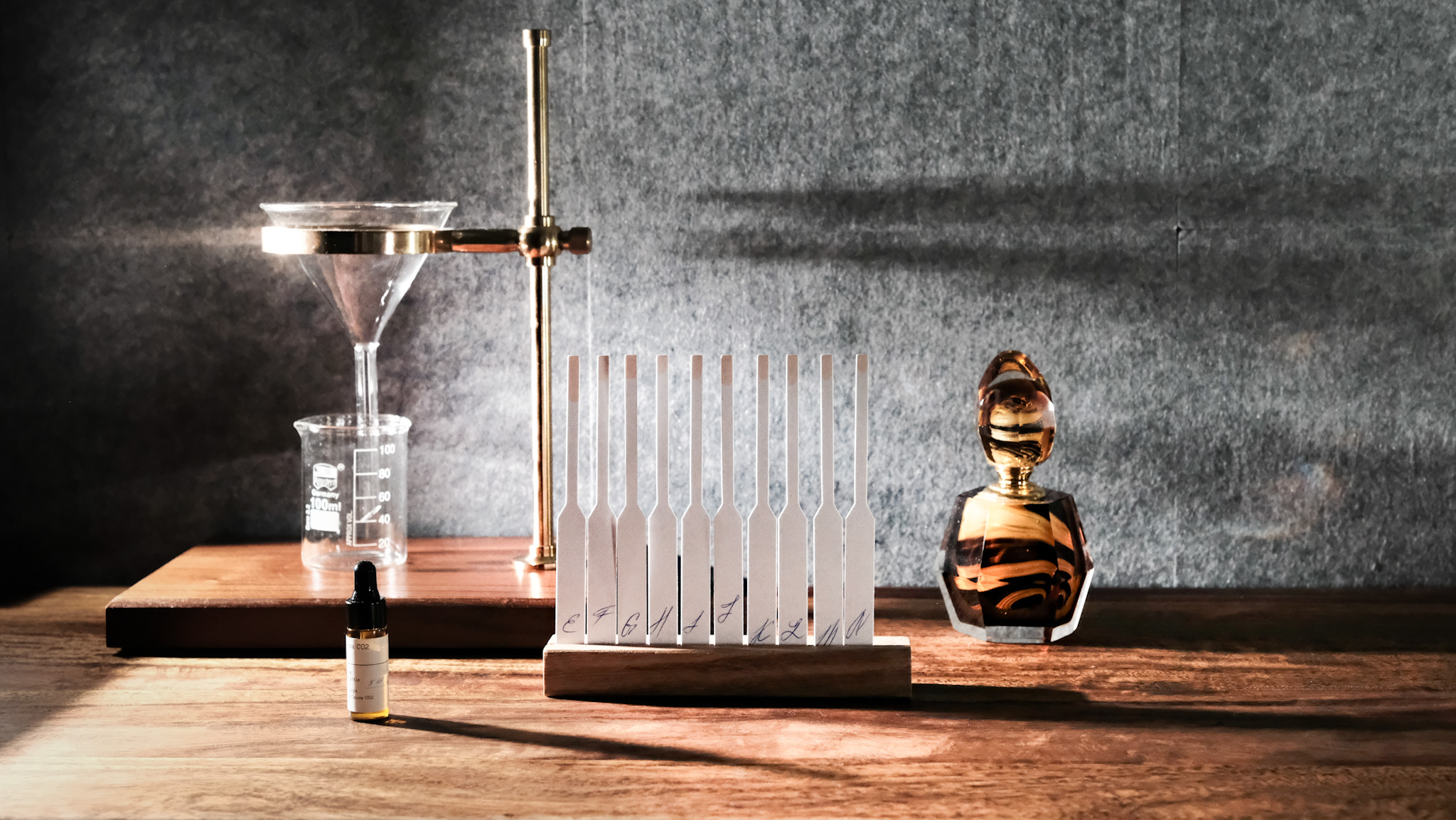
Fragrance Building Principles: Method of Perfume Creation
Adapted from Jean Carles, December 1961
Historically, the chypre family has held a special place in perfumery, particularly for its unique interplay of base notes like oakmoss and labdanum, balanced by floral or animalic hints in the heart, and fresh top notes such as citrus. In this article, we will learn how to build perfumery accords step by step, focusing on a basic chypre framework as a guiding example. The method outlined here demonstrates a systematic approach to building, modifying, and refining an accord—so that each layer harmonizes with the others while preserving the signature “chypre” identity.
A Method of Chypre Perfume Creation
The Base “Accord”
Oakmoss absolute is the keystone of a chypre fragrance. It belongs to the low-volatility (“base note”) category, along with materials such as Patchouli, Labdanum (Cistus), Coumarin, and certain musks. Many classical chypre formulations also involve products like Ionones, Vetiver, and other deep, long-lasting ingredients that complement oakmoss.
Step A: Selecting Two Base Materials and Testing Ratios
First, pick a primary base ingredient (here, Oakmoss absolute) and a secondary one (here, Coumarin). Blend them in small, incremental steps (each step = 1 drop or unit), ensuring Oakmoss remains dominant:
| Experiment # | Oakmoss Absolute | Coumarin |
|---|---|---|
| 1 | 9 | 1 |
| 2 | 8 | 2 |
| 3 | 7 | 3 |
| 4 | 6 | 4 |
| 5 | 5 | 5 |
Smell each trial on a blotter. Do not go beyond a 5:5 ratio, since the goal is to keep Oakmoss as the main characteristic of this accord.
Suppose you find that a 6 Oakmoss : 4 Coumarin blend gives the best balance—pleasantly mossy yet subtly sweet.
Step B: Enriching the Base, Adding a Musk Note
Classical chypres often have a musky undertone. Let us add 1 part of a musk material (e.g., Musk Ketone). Thus, our base blend might be:
6 Oakmoss Absolute 4 Coumarin 1 Musk Ketone
Step C: Exploring Additional Base Notes (Labdanum & Patchouli)
We can further modify the base by testing small combinations of four materials at once. For instance:
| A | B | C | D | |
|---|---|---|---|---|
| Oakmoss Abs. | 4 | 6 | 3 | 3 |
| Coumarin | 4 | 3 | 6 | 3 |
| Patchouli | 4 | 3 | 3 | 6 |
| Musk Ketone | 1 | 1 | 1 | 1 |
In each column, the dominant material changes. “A” might be well-balanced, “B” has more Oakmoss, “C” emphasizes Coumarin, “D” pushes Patchouli, etc. Pick whichever profile is most appealing and keep that as your “base accord.” Often, selecting a different set of base materials—such as Ambergris-type products or Vetiver—will significantly shift the chypre’s foundation.
The Modifiers (Heart Notes)
The immediate smell of raw Oakmoss + Coumarin + Patchouli (etc.) might be overpowering or harsh. To tame and beautify the base, we add medium-tenacity notes—often florals or soft animalic nuances—called “modifiers.” In some classical references, rose absolute or jasmine could be used, or a hint of civet for an animalic touch.
For example, we might decide on:
3 Jasmine Absolute 1 Civet (10% solution) or similar animalic note
These ingredients will soften the base’s rough edges, lend a floral glow, and introduce subtle sensuality. By varying this step (e.g., choosing Rose instead of Jasmine, or adding a hint of spicy Clove), you alter the perfume’s central “heart.”
The Top Notes
Lastly, we incorporate very volatile materials for the initial fresh impact—often citrus or green notes. In a chypre, Bergamot is traditional, but we can also include Sweet Orange or Lemon. As Jean Carles suggested, test these top notes in small ratio steps:
| Experiment # | Bergamot | Sweet Orange |
|---|---|---|
| 1 | 4 | 1 |
| 2 | 3 | 2 |
When you find a pleasant mini-accord, add it atop your Base + Modifiers. Typical top notes can be expanded to include other light, sparkling ingredients, depending on the perfumer’s inspiration.
Putting It All Together
Jean Carles emphasized that the relative percentages of Base, Heart (Modifiers), and Top are crucial for a balanced evaporation curve. For a classic chypre, you might allocate:
- Base (~55%) – Oakmoss–Coumarin–Labdanum–Patchouli + Musk
- Modifiers (~20%) – Jasmine, Civet trace
- Top (~25%) – Bergamot and Sweet Orange
A possible simple formula:
Base (55%) 6 Oakmoss Absolute 4 Coumarin 1 Musk Ketone (+ small increments of Labdanum & Patchouli if desired) Modifiers (20%) 3 Jasmine Absolute 1 Civet (10% solution) Top (25%) 4 Sweet Orange 1 Bergamot
These numbers (6, 4, 1, etc.) are “parts” or “drops,” which you then convert into percentages (e.g., 6 parts is 6 out of total parts counted).
Endless Variations
Once the core chypre note is established, the formulation can be endlessly extended or modified by selecting additional base notes (such as Vetiver or Patchouli), trying different floral or animalic modifiers, or substituting new top notes altogether. Each small change generates a new fragrance within the broader chypre family, highlighting the perfumer’s creativity.
By systematically writing your formula in three tiers—Base, Modifiers, Top—and altering one tier at a time, you can generate infinite chypre variants. This approach allows both beginners and experienced perfumers to craft novel perfumes while preserving the defining “chypre” identity.
Single-Vessel Experiments
If you have a sufficiently trained nose to detect concentration changes in real time, you can speed up your workflow and conserve materials by using a single vessel. In this method, all components are added step by step into one container, and after each addition, you take a blotter sample to evaluate the new mixture. This way, you can achieve a similar gradient of different concentrations on separate blotters, rather than having to prepare multiple vials for each test.

The main advantage is efficiency: it’s faster, simpler, and more economical. However, if you overshoot the concentration of any one component, you may need to start over. Another drawback is that your trial stages exist only on blotters, which fade over time. If you want to compare results after 30 minutes, you might find some key notes already diminished or gone.

Working by drops also simplifies experimentation, yet scaling up is tricky. Differences in density mean that one drop of a thick material could weigh more than one drop of a lighter material. Converting from volume to weight properly requires measuring densities—often by weighing 1 ml of each substance or solution.



Pingback: Diary of an Experimental Perfumer - olfactive aesthetics author's niche perfumery
February 16, 2025
Pingback: Perfume base - how to build it and why.
March 23, 2025
Pingback: From Concept to Bottle: The Lifecycle of a New Perfume - olfactive aesthetics author's niche perfumery
April 2, 2025